(2 PM – promoted by TheMomCat)
This piece is a summary of a paper that I presented at the Left Forum in a panel organised by Geminijen. If you want to see a copy of the longer paper (which is being edited for English and clarity), send me a personal message here with your email and I will send it to you. Fran Luck who is the producer of the radio series “Joy of Resistance: Largest Minority” on WBAI was in the audience and asked us to appear on her show. If you would like to listen to Geminijen, Diana Zevala (who has written for the ACM on education), Barbara Garson and me, please click here: http://archive.wbai.org/files/mp3/wbai_130703_210001wed9pm10pm.mp3).
While in no way denying the impact of the introduction of austerity upon the working class, the disabled and the poor as a whole, there is no question that the impact of austerity on women is far greater. This is due to the job losses in the state sector where women’s labour is predominant, our historically lower wages due to the undervaluation of traditional women’s labour in a capitalist labour market leading to greater dependence upon the social welfare state, and our overwhelming responsibility for reproduction of the working class and how that impacts on our working lives. The failure of the state to provide completely for social reproduction especially in childcare and care for the infirm and disabled has resulted in women having: 1) discontinuous working lives; 2) and the predominance of our labour in part-time employment.
With incomes falling in the advanced capitalist world as part of general economic policy, women face greater threats than men due to our responsibility as primary caretakers of children, the disabled and the elderly. Women are facing lower incomes, lower pensions, and an increasing reluctance for the state to support women in the workplace through provision of child-care and after-school programmes and shouldering carer responsibilities for the elderly and infirm. Given the transformations in general employment possibilities towards increasingly underemployed and part-time labour, we will begin to face competition from men for the jobs we have normally held while benefits are increasingly run down.
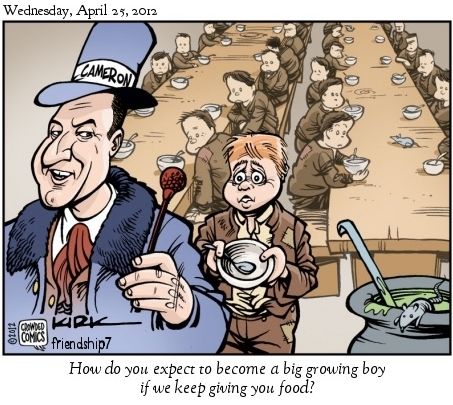
We face increasing economic insecurity without sufficient state assistance to ensure that our children and families can have a decent standard of living provided through employment. Women can no longer depend upon the fact that our labour is of sufficient value to capitalists as men also face increasing precariousness in their employment, and in the absence of a strong labour movement or left-wing movements, can serve the same role of an easily intimidated low-paid work force.
The destruction of the public sector enabling the weakening of the last bastion of trade union organisation to force through even lower wages and a reduction in social subsistence levels of wages along with a further deterioration in working conditions on the basis of non-competition with emerging and peripheral economies is nothing less than a race to the bottom and women will be the first, but not the last, victims of neoliberal economics in the advanced capitalist world.
This piece will be divided into 3 parts. The first is composed of some general statements on austerity. The second part will discuss the women’s labour market in Britain and the impact of austerity. The third part addresses the attack on the universal social welfare state in Britain and its impact upon women.
Part I: What is “Austerity” and why is it being introduced?
What is called austerity is not a new series of economic policies; these policies were introduced by the World Bank in Latin America and Africa and are now being introduced in the advanced capitalist world either voluntarily by governments in (for example, in Britain) or forced through by the Troika of the EU, European Central Bank, and IMF in Greece, Ireland, Spain, and Portugal, for example.
The term austerity is misleading implying that across classes the whole country is facing cutbacks and lower levels of incomes. That is false. Overwhelmingly, the burden of austerity falls on the working class and the poor; and of these, women and those with disabilities are impacted the most.
Austerity is not shared equally by all classes. A cursory look at Figure 1 below, demonstrates quite clearly that those that have been hit hardest are the two lowest incomes deciles which relate to those whose incomes derives completely from benefits (poorest) and the working poor (second lowest decile).
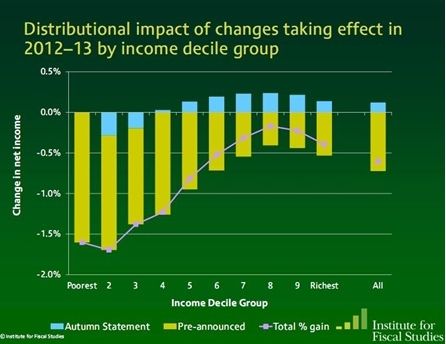
(Source: http://www.ifs.org.uk/comms/co… P 52)
The formal excuse or justification for the introduction of austerity in Britain has been to cut the Deficit /GDP. While it is dubious economic policy to cut budget deficits in the middle of an economic crisis (as a grotesque understatement) and while there is no historical evidence that this is an effective way of stimulating the economy or economic growth, this is the neoliberal perspective that is justifying cutting the budget deficit. Instead of increasing government revenue through financial transaction taxes, increased taxation of corporations or higher personal incomes, this is done through cutting the state sector and by cutting expenditures. Increasing wealth and income differentials in a period of economic crisis is dubious and will definitely lead to increased financial and economic instability.
Its introduction is part of a longer term attempt to recover profitability in the advanced capitalist world. While the financial sector recovered very quickly from the crash due to the bail-outs and the resulting centralisation of capital eliminating redundant capital, the same cannot be said of other sectors in the economy.

Its introduction is part of a longer term attempt to recover profitability in the advanced capitalist world. While the financial sector recovered very quickly from the crash due to the bail-outs and the resulting centralisation of capital eliminating redundant capital, the same cannot be said of other sectors in the economy.
Using the crisis as a justification for increasing income and wealth inequality, governments believe that it will enable economic growth; in other words, politicians and the IMF, EU and ECB are trapped in a delusional supply-side and monetarist economic policy mentality.
Essentially, the purpose of austerity is twofold and the reasons are interrelated:
1) Using the excuse of competition and economic stagnation, given low profitability outside of the financial sector, the economic crisis is being used to squeeze wage incomes to keep profits up. This is part of a longer term attack on workers’ incomes that began in the late 1970s and its purpose is to undermine workers’ incomes and working conditions in the advanced capitalist world due to continuing profitability problems outside of the financial sector which is what led to the shift of industry and manufacturing to emerging and peripheral capitalist economies;
2) Secondly, the privatisation of potentially profitable areas of the public sector is being introduced. Its purpose is to open up new areas of profitability for capital and also to undermine the trade unions in the public sector in the last bastion of unionisation in the advanced capitalist world.
First, the shrinking of wage incomes over time (this has been happening in the advanced capitalist world since the late 1970s due to the destruction of industrial and manufacturing sectors and the commensurate destruction of the trade union movements) and in the absence of access to either easy, but expensive, credit or an universal social welfare state which maintains incomes means that the possibility of realisation crises have increased. I would argue that this is a major part of the current stagnation in the advanced capitalist world as in the absence of consumption, profits remain unrealisable and there is no reason to increase employment, production and investment.
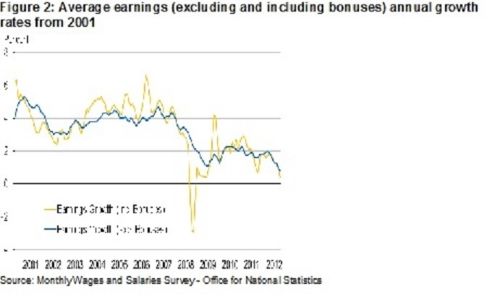
Add to this, the shift away from full-time work with benefits and decent working conditions towards increased part-time, temporary and sub-contracting work. Inevitably, these forms of labour (often not unionised) have lower wages due to their unskilled nature. While in the EU (unlike in the US), part-time workers will still get comparable wages to a full-time worker, they still get holidays and sick days, however, the type of work means that wages will be lower. Rising levels of underemployment are clearly demonstrated from the period of April-June 2000-2012; as we can see the rate of underemployment (calculated by dividing the total number of underemployed workers by the total number of people in employment who have known underemployed status for a year) increases from 7.1% to 9.5% between the years of 2008-9 and has continued to rise to 10.5% in 2012. If we solely look at part-time workers, the rate of underemployment is obviously more evident going from 2000 at 18.4 downwards to 2012 to 24.0.
Two important points to make, of those that are underemployed, the vast majority would prefer to work additional hours in the same job rather than get an additional one; moreover, this is rising for both men and women and is essentially part of the new reality for working conditions in the advanced capitalist world. From 2008-2012, the percentage of men that are underemployed has risen from 24.8% to 34.6% and for women it has risen from 15.6% to 21%.
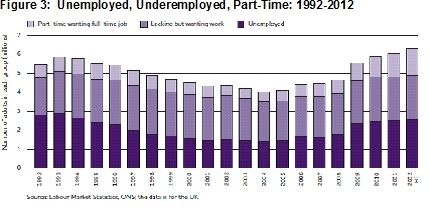
Second, those lower incomes means that things that people formerly got for free at the point of contact with the social welfare state will not necessarily be demanded once formerly socialised sectors are privatised. That means that they may no longer be as profitable as anticipated. If you need to pay for health care, chances are you will ration using it; this is more relevant to Greece whose health care system is no longer free at the point of contact for those unemployed for over 1 year (and that number is rising due to the introduction of austerity) and in Spain where people are fighting healthcare privatisation measures.
Third, and most obvious, privatisation of these services means that they are subject to a profit criteria under capitalism; this will most assuredly affect access to services in terms of supply for the working class and poor. All the so-called arguments about competition become laughable when something becomes privatised and inevitably monopolised due to the nature of provision and the demands of the system itself. In the case of child-care and caring for the sick and elderly, this work will inevitably fall on women as part of caring for extended families for which women are still predominately responsible.
Part II: Austerity and the women’s labour market
Austerity is hitting women harder than men. This arises both in terms of their roles as workers where they are more heavily concentrated in the public sector and in the general economy where their pay is lower and their working lives are less continuous due to family responsibilities and as the main providers of social reproduction. Hence women are more dependent upon the social welfare state.
As workers, cutbacks to the public sector impact upon women more than men due to their employment being concentrated in the public sector. According to UNISON (a public sector workers union), 65% of public sector workers are women, and almost a quarter of working women are in public sector jobs in Britain. Specifically of the 6,798,000 who viewed themselves as public sector workers in the second quarter of 2012, 4,439,000 were women and 2,359,000 were men. This situation holds in general throughout Europe.
There is strong evidence of pay differentials (and pension provision) between public and private sector workers and it is clearest for women. In a study of countries in the Euro Area, it was shown that public sector wages are higher compared to private sector pay and this is especially the case for women in both supervisory and non-supervisory roles and especially for women in lower paid work (See Giordano, et al). It must be clarified that this derives from the weakness of unions in the private sector in areas in which employment opportunities exist. For women, it also relates to the fact that they are still trapped in low-paying service sector work in the private sector (e.g., retail and sales) and in traditional labour which is inevitably lower paid due to its undervaluation under capitalism. In commensurate employments in public and private sector (e.g., cleaning), wages and job protections are lower due to lack of union protections.
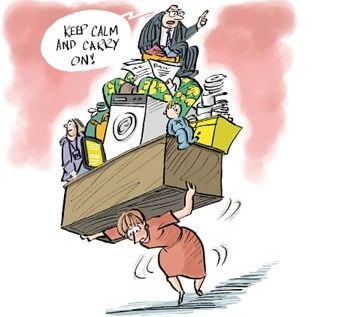
Women’s Labour is Predominantly Based in part-time work.
Given that part-time work provides lower incomes, this already places these workers at a severe disadvantage. In some cases, women do it voluntarily to cover child-care and other carer responsibilities, preferring the flexibility afforded by working part-time. However, what has also happened is that women are unable to work full-time formal work (due to lack of affordable child-care and carer availability); we are also seeing relegation to the part-time sector due to the fact that full-time employment possibilities are decreasing. That is, we are seeing a situation of involuntary underemployment. Disproportionate concentration of women in part-time work is not decreasing. According to the Equality and Human Rights Commission, this is predominately due to carer and household responsibilities.
If we look at economic inactivity (defined as those not in employment but who are not considered unemployed as they have not been seeking work in the last month and cannot begin work within 2 weeks) in January-March 2013: out of a total of 9,003,000 of people that are economically inactive in Britain, 2,282,000 people cite household and caring responsibilities for the reason for economic inactivity, of these 220,000 are men, while 2,063,000 are women. Of the 2,299,000 of the total that say that they want a job, 630,000 say that they are looking after home and family; of those 76,000 are men as compared to 556,000 women.
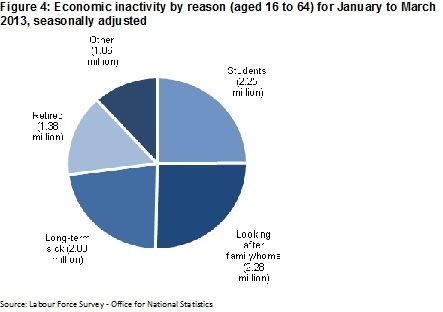
Working in the informal sector again characterises women’s work. This is especially so for immigrant labour and that of the poorest members of society. Essentially precarious in nature; the fact that more and more people are resorting to them as the formal economy is failing to provide sufficient levels of income or employment is serious. These types of jobs also include domestic labour of various kinds (nannies, carers for the elderly and infirm, cleaners), door-to-door sales (think of the Avon lady for example) and are heavily dependent on incomes of those that are employing them. So, immigrant women are facing additional economic hardship and even more increased precariousness as the incomes of those that employ them fall.
Pensions
In Britain, increases in retirement age for women are being gradually phased in; instead of being able to retire earlier than men, the retirement age is being increased from 60 to 66 by 2020. This, combined with pay freezes, increased contribution to pension schemes, and the re-pegging of pensions to a Consumer Price Index (CPI) (as opposed to the Retail Price Index or RPI which includes housing) to address inflation mean that public sector workers are working longer and harder (due to job cutbacks), for less pay, for a pension that is actually going to be lower. Women live longer than men and have had lower incomes (both in terms of pay for the same jobs and the fact that “women’s work” pays less). Their pension contributions and pensions will be lower. Women that are able to retire will be living longer on lower pensions (while women that are married may get their husband’s higher pensions upon their deaths; this does nothing for single women or single mothers). This means that more women will be living in poverty.
Part III: Cuts in Social Services and the impact upon Women
The destruction of the universal social welfare state impacts far more on women who are inevitably more dependent upon benefits. Women are more heavily employed as part-time and temporary labour (both voluntarily and forced) due to carer responsibilities and that means a far lower income than someone doing the job full-time; this means they are more dependent upon benefits to cover living expenses. On average, one-fifth of women’s income is made up of welfare payments and tax credits compared to one-tenth for men. A total of £14.9 billion worth of cuts per year have been made to benefits, tax credits, pay and pensions, with 74% of this taken from women’s incomes. In the UK, lone parent households are predominately female (92%, compared to 8% of men leading lone parent households; Lone parents with dependent children represented 26% of all families with dependent children in 2011) and they are feeling the impacts of the cuts far harder (see, http://www.fawcettsociety.org…. ).
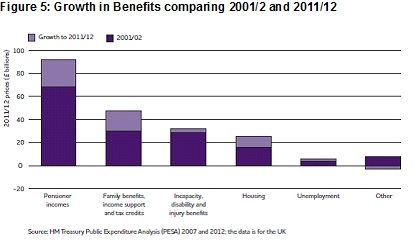
Benefits are being capped at £500/week for those households with couples and lone parent households (single adult household with no children benefits will be capped at £350/week).
Even the government acknowledges that the impact will fall primarily on women:
“[…] 60% of customers who are likely to have their benefit reduced by the cap to be single females, but only around 3% to be single men. Most of the single women affected are likely to be lone parents, […] we expect the vast majority of households affected by the policy (around 90%) to have children. Around 60% of those that are capped are single women. Single women form 40% of the overall benefit population. (http://www.dwp.gov.uk/docs/eia-benefit-cap-wr2011.pdf, p. 8).”
One of the benefits included in the benefit cap is Housing Benefits. These are being capped as an attempt to clear the poorest from the centre of London. 50% of those receiving housing benefits are single women (couples 20%, single men 30%). There are insufficient amounts of public housing (both due to the sell-off under the Thatcher years and insufficient amounts built afterwards). Long waiting lists and insufficient public housing especially for large families are the rule. Lack of rent control in private housing (eliminated under Thatcher) and the rise of buy to let has meant that rents in London are skyrocketing. With housing benefits capped, there is a danger that people will take money from their other benefits to cover housing. Additionally, the bedroom tax (or over-occupancy charge) for “extra” bedrooms for those in social housing are hitting people with disabilities disproportionately and single mothers disproportionately (http://www.guardian.co.uk/society/2013/mar/04/benefits-housing).
Of primary importance, there is the stealth cut of re-pegging of benefits and pensions to the CPI (as opposed to the RPI which covers housing costs); this means that increases in benefits and pensions will certainly be at a lower level as the CPI is lower than the RPI due to lack of inclusion of changes in housing costs primarily and these are rising. This re-pegging of benefits accounted for the largest cut in government expenditure and the attempt in the US to change the index for social security from the CPI to a chained CPI is attempting to do the same. This is a real cut in future incomes and it would not be introduced if it was not a cut. A report from the Joseph Rowntree Foundation showed that:
“Over the past five years:
A) Childcare costs have risen more than twice as fast as inflation at 37%
B) Rent in social housing has gone up by 26%
C) Food costs have increased by 24%
D) Energy costs are 39% more
E) Public transport is up by 30%
Since 2008 the Joseph Rowntree Foundation has said real inflation had climbed by 25% rather than the 17% increase as judged by the Consumer Price Index (CPI), the method used by government to measure inflation (http://www.jrf.org.uk/publications/MIS-2013).”
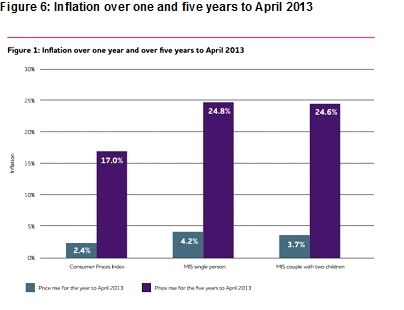
To rub salt in the wounds, there has also been a benefit freeze of 1% introduced (benefits cannot increase by more than 1% for the next three years; far lower than the rate of inflation even calculated under the CPI of 2.4%). Laughingly the 1% freeze on benefits is being justified by the fall in real wages for the employed and that people on benefits should not get an increase in income greater than the employed. The social subsistence level of wages for working people in the economy is being undermined. The ideological argument essentially means that those on benefits are being forced to physical minimum. There is rising usage of food banks and reports that mothers are foregoing eating to feed their children indicates a serious erosion of standards of living.
According to the Trussell Trust:
“More than 350,000 people turned to food banks for help last year, almost triple the number who received food aid in the previous year and 100,000 more than anticipated, according to the UK’s biggest food crisis charity (http://www.guardian.co.uk/society/2013/apr/24/number-people-food-banks-triples).”
Universal Social Welfare State?!
Unlike the US where the social welfare state is relegated to the poor and the disabled and sick, these cuts affect women across classes as the social welfare state is universal in Britain. Movement towards means testing of benefits is impacting upon middle class women as well as working class women. This is certainly the case with child benefits, working people’s tax credits (WTC) and child tax credits (CTC) which previously were universal and not means tested. For example, the 2010 budget froze the rate of child benefit for 3 years until April 2014; given inflation and rising living costs, the value of child benefit will have been cut by 10% until 2014. A family with1 child will be £130/yr worse off; those with 3 children will be £285/yr worse off (see, http://www.fawcettsociety.org…. ). Needless to say those more dependent upon benefits (those with low incomes) will feel this far worse.

While the government claims that it is helping people into work that clearly does not include women as they actually cut the childcare portion of working tax credits from 80-70% in the 2010 budget. This particularly affects single mother households as 60% of the recipients of the childcare element are single working mothers. To make it even worse they have increased the number of working hours needed to qualify from 16-24 hours per week; finding 8 additional hours in a period of high unemployment is not particularly easy. Invariably women will have to drop out of work as they cannot afford childcare and/or they cannot find the remaining 8 hours to even get the 70% covered by the government.
Disability benefits are being undercut:
The government has introduced assessments to determine eligibility for Disability payments both in terms of what used to be called Incapacity Benefits (now Employment Support Allowance) and Disability Living Allowance (DLA; now called Personal Independence Payments) which are used to cover the extra costs of living with disabilities. Carer’s Allowance is tied into receipt of DLA; if you are deemed ineligible for DLA, you will lose access to Carer’s allowance. This is the case irrespective of whether or not you will need to continue to care for a disabled or infirm person. Finally, the Independent Living Fund (ILF; enabling people with disabilities to live on their own rather than in group homes or with their family) has been shifted to local governments with no additional funds provided to ensure that the ILF can be accessed. This will mean additional carer responsibilities for parents and carers as their disabled family members are no longer able to live independently. Moreover, cuts to disability benefits are being targeted at those that have what are called fluctuating conditions which women are more susceptible to like Fibromyalgia, arthritis, ME, and mental health conditions like depression and anxiety.
Finally, women will be affected due to local government forced cuts which affect after-school programmes, availability of outside carer assistance in homes, and protection against domestic violence as cuts are impacting upon these programmes.
Conclusion
It is extremely disheartening and infuriating to watch decades of struggle be undermined so quickly. But it is essential to keep fighting for these gains and to organise opposition to these policies. We may lose, but we cannot go down without a fight. We have always faced difficulties due to the use of divide and rule between men and women, between skilled and unskilled workers, between white and people of colour, between employed and unemployed. Governments are working very hard to foster disunity, but we know that unity is strength and this is a fight from which we simply cannot walk away and hope for the best!
References
Mike Brewer, James Brown and Robert Joyce (2011) “Child and Working-Age Poverty from 2010-20,” Institute for Fiscal Studies, http://www.ifs.org.uk/comms/co…
Department of Works and Pensions, Household Benefit Cap, Equality Impact Assessment, October 2011, http://www.dwp.gov.uk/docs/eia…
Equality and Human Rights Commission (EHRC) “Women, men and part-time work – January 2013,” (http://www.equalityhumanrights.com/scotland/legal-news-in-scotland/articles/women-men-and-part-time-work/).
The Fawcett Society, February 2013, “The triple jeopardy: the impact of benefit cuts on women” http://www.fawcettsociety.org….
Raffaela Giordano, Domenico Depalo, Manuel Coutinho Pereira, Bruno Eugène, Evangelia Papapetrou, Javier J. Perez, Lukas Reiss, and Mojca Roter (2011) “The Public Sector Pay Gap in a Selection of Euro Area Countries,” European Central Bank, Working Paper Series, No 1406 / December (http://www.ecb.europa.eu/pub/pdf/scpwps/ecbwp1406.pdf)
Donald Hirsch, A Minimum Income Standard for the UK in 2013, Joseph Rowntree Foundation Report, 28 June 2013, http://www.jrf.org.uk/publicat…
ONS, Underemployment rate1, 2 for part time workers by sex, July to September 2012, 2011 and 2008, UK , ONS, January 2013,Underemployment levels and rates for regions of Great Britain
ONS, Underemployment levels and rates for regions of Great Britain, October 2010-2012, 001024
Office of National Statistics (5/2013) Summary of Labour Market Statistics, http://www.ons.gov.uk/ons/rel/…
ONS, labour market statistics, May 2013, “INAC01: Economic inactivity by reason,” http://www.ons.gov.uk/ons/publ…
newquery=*&newoffset=25&pageSize=25&edition=tcm%3A77-263579
Unison, Women and Public Spending Cuts, Factsheet #21, June 2011, http://www.unison.org.uk/acrob…
